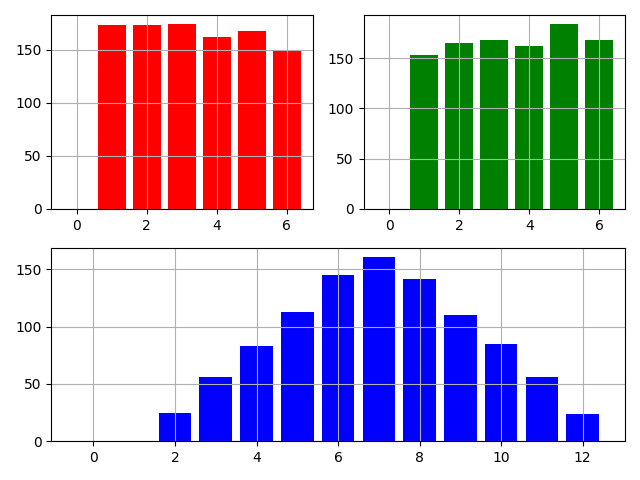Simulazione del lancio di due dadi (come somma degli esiti di due dadi singoli)
import random LANCI=50 def dado(): return random.randint(1,6) for i in range(LANCI): dado1=dado() dado2=dado() esito=dado1+dado2 print(esito, end=' ')
Frequenze
Conteggio delle uscite e calcolo finale delle frequenze assolute e relative
import random
LANCI=10000
def dado(): return random.randint(1,6)
# 1 2 3 4 5 6 7 8 9 10 11 12
CONTO=[ 0, 0, 0, 0, 0, 0, 0, 0, 0, 0, 0, 0, 0]
for i in range(LANCI):
dado1=dado()
dado2=dado()
esito=dado1+dado2
CONTO[esito] += 1
for f in range(2,13):
print("%2d: %4d %5.2f%%" %(f, CONTO[f], 100*CONTO[f]/LANCI))
matplotlib
Le frequenze assolute degli esiti dei due dadi e delle loro somme

import matplotlib.pyplot as plt
import matplotlib.gridspec as gridspec
import random
LANCI=1000
DADO1= 7*[0]
DADO2= 7*[0]
ESITI=13*[0]
def dado(): return random.randint(1,6)
for i in range(LANCI):
dado1=dado() ; DADO1[dado1] += 1
dado2=dado() ; DADO2[dado2] += 1
esito=dado1+dado2; ESITI[esito] += 1
print("DADO 1", DADO1)
print("DADO 2", DADO2)
print("DADI ", ESITI)
fig=plt.figure(tight_layout=True)
gs =gridspec.GridSpec(2, 2)
ax=fig.add_subplot(gs[0, 0]); ax.bar(range(7) , DADO1, color="red" ); ax.grid()
ax=fig.add_subplot(gs[0, 1]); ax.bar(range(7) , DADO2, color="green"); ax.grid()
ax=fig.add_subplot(gs[1, :]); ax.bar(range(13), ESITI, color="blue" ); ax.grid()
plt.show()